Behold, Egyptologists! Our Authors of the Month for July are Jonathan Meader and Barbara Demeter, with a short presentation based on the newly abridged version of their much revered and simply stunning book, Ancient Egyptian Symbols: 50 New Discoveries.
Carol Andrews: “This remarkable publication challenges the world of Egyptology to reassess long-held and clearly incorrect theories about the origin and meaning of so many symbols and representational forms which are fundamental to our understanding of ancient Egypt.” (Amulets of Ancient Egypt, British Museum Department of Egyptology, 27 years).
Herman te Velde: “This is a very fine book… beautiful and instructive… I recommend it wholeheartedly.” (Seth, God of Confusion, 1967)
James P. Allen: “Innovative and thought-provoking, with some important contributions to Egyptology.” (President 2011-15, International Association of Egyptologists, Metropolitan Museum 16 years)
Andrew Weil: “Remarkable discoveries that, once seen, are completely obvious. A revelatory work.” (MD, 10M books sold)
Martine Rothblatt: “A momentous work of art and deep reservoir of revealed knowledge… seeing what everyone else has seen, but thinking what no one else has thought.” (PhD, JD, MBA; founder Sirius Satellite Radio and United Therapeutics)
Ancient Egyptian Symbols: 50 New Discoveries (Abridged) (128 pgs., 260 illus., soft: £14 €18 $20).
– By Jonathan Meader & Barbara Demeter
Foreword by Hans Schneider (Director Rijksmuseum van Oudheden, 10 years; Deputy Director of Anglo-Dutch excavations, Sakkara, Egypt, 20 years).
Barbara and I have spent the last 13 years searching for the sources and meanings of ancient Egyptian symbols. Our research focused on the two ancient Egyptian Sacred Waterlilies, ancient Egyptian symbolism, and the three primary Egyptian funerary texts – all ancient sources. We’ve traveled to Egypt many times, and to museums in Europe and the US to study and photograph the ancient symbols. We discovered the sources and meanings of more than 50 ancient Egyptian symbols, including Seth’s mysterious head, the Eye of Horus, 10 major crowns, and the symbolic foundations of Osirian mythology, the backbone of ancient Egyptian religion for more than 2000 years.
I’m an artist (jmeader.com), and I lived in Lebanon and Morocco as a teenager. Barbara is a business consultant, specializing in the mortgage and banking industries.
Note to reader: Dates in our book are abbreviated: c. 1250 BC = •1250, and c. 30 AD = 30•. Sacred Waterlilies and Sun symbols are capitalized, but the Waterlily’s sun is not. Several symbols’ names were changed when their sources and meanings were discovered.
“The purpose of all true symbols is to direct the individual away from the superficial concerns of life towards the center of existence… the true symbol always points beyond the here and now for it is a signpost to another world… each fragment points to the whole and everything ephemeral is in an image of the eternal.”
– Manfred Lurker, The Gods and Symbols of Ancient Egypt.
1: This copy of a painting from an ancient Egyptian tomb is filled with Sacred Blue Waterlily symbolism: her headband, the bud over her forehead, the flower over her arm, the bloom he is contemplating, and the bouquet of Waterlilies in front of them. Sacred Blue Waterlilies are ubiquitous in ancient Egyptian tomb paintings. What is their significance?
Egyptologists have wondered why, in one particularly beautiful ancient Egyptian myth, the Sun is said to rise from a Sacred Blue Waterlily (not a lotus). So, one day in early 2002, Barbara brought home several blue waterlilies (of the modern variety) for us to examine to try and solve that mystery.
It didn’t take long, for in the center of the first blue waterlily we examined a tiny orb: a translucent, yellow tinted “sun.” Some light reflected off its surface and some passed through it, making it appear to glow. Ancient Egyptians believed things that resembled each other were related, and that “similarities” were important clues left by the Gods and Goddesses to help people make sense of the world. Resemblance was the basis for ancient Egyptian symbolism – symbols (usually) resembled what they represented.
2: The Blue Waterlily’s bud rose out of the black waters of Chaos and began to glow with the world’s first light, pushing back the darkness. The flower’s sky-blue petals unfurled, its yellow stamens spread, and from its center the nascent sun, Ra, rose for the first time…and our fragile world began.
We decided to use only the two ancient Egyptian Waterlily varieties and contacted Ken Landon. Ken, at the request of the Egyptian government, identified flower remains found in ancient Egyptian tombs. He also supplied Egypt with millions of seeds of the two ancient varieties when construction of the High Dam wiped out the Waterlilies in the Delta. Ken grew all of the Waterlilies photographed in our book.
The Waterlilies began arriving overnight from Texas, and I dissected and photographed them. Simultaneously, I immersed myself in the study of ancient Egyptian symbolism, and the combination of the two led to an avalanche of discoveries. This was virgin territory – no one had ever examined the two Sacred Waterlilies as possible sources of ancient Egyptian symbolism, or even looked to see why the Blue Waterlily was said to be the source of the Sun.
3: From left to right: top view of a Blue Waterlily’s ovary, swollen with approximately 2000 seeds. Seeds go through several color changes – translucent to red to brown/black. A Waterlily seed can be seen slipping out of its “life-vest,” which can keep it afloat for up to 8 hours, allowing it to travel some distance before sinking and taking root. Waterlilies also have horizontal roots (rhizomes) from which new stems grow.
It soon became evident that the two Waterlilies, ancient Egypt’s most revered flowers, were the most important building blocks of their symbolism. They were the inspiration for a number of crowns and other major symbols. Waterlilies were especially valued because they were democratically employed sources of symbolism, whereas Sun Disks were only used with royalty and the Gods.
Waterlilies, which rise spotlessly from the mire, were a source of food and medicine in ancient Egypt. The Blue Waterlily’s subtle aroma indicated the presence of Gods and Goddesses, some of whom played essential roles in the resurrection process. Waterlilies were primarily resurrection symbols.
4: The cobras in Princess Meritamun’s Cobra-Ring Crown (© Liepe) each has a Sun on its head. Her crown resembles the center of a Blue Waterlily. These stylizations have previously been identified as different crowns. The shapes at the top of Djed Pillars are 3 Cobra-Rings, which equal 3 times the power of Sunrise.
The Blue Waterlily’s center (stigmatic basin), with its sun in the middle, inspired considerable ancient Egyptian symbolism. Radiating out from its sun are serpent-like stigmas, each ending in a curl (style) that can resemble a flaring cobra – a ring of cobras around a rising Sun. As a crown it has been called “Uraei Kalathos,” or royal cobra basket. However, that proved too limited, so the term “Cobra-Ring” is applied instead.
5: One cobra around a Sun Disk is also a Cobra-Ring and is inspired by the Blue Waterlily. Waterlily petals shown encircling a face imply that face is the Sun because of the sun at the Waterlily’s center. The petals also imply scent because a Blue Waterlily’s scent is in its petals. The White Waterlily doesn’t have a discernable scent. Shapes referred to as “rosettes and roundels” are usually Waterlily centers, as are the flower designs on the breasts of some royal women’s statues; the glyph for the Sun, the Solar Eye, the Solar Boat, and the stack of three stylized Cobra-Rings at the top of Djed Pillars.
6: The Sacred Ancient Egyptian White Waterlily, although less familiar than the Blue Waterlily, was equally vital in the development of ancient Egyptian symbolism. Its petals are thicker, wider and blunter, and the top half of its vase-like cluster of stamens is often colored yellow. Both Waterlily flowers rise 5– 8 inches above the water and bloom for 3 days or nights, after which they sink to the bottom and spend the next 4– 6 weeks developing seeds. They open and close daily, as do many flowers, but they do not rise and sink with the rising and setting of the Sun, as has been suggested.
7: A White Waterlily bloom opens shortly after Sunset and stays open until noon the following day (16 hours), whereas the Blue Waterlily is only open from mid-morning to mid-afternoon (4 -7 hours). Neither Waterlily is open at Sunset, which was the most dangerous time for the Sun – it was when Ammut, the huge death serpent attacked. However, Seth was on hand to temporarily repel him, and the red streaks in the sky at Sunset and Dawn were imagined to be blood from Ammut’s wounds.
8: The White Crown was inspired by a White Waterlily’s stamen cluster, with its sun/Sun rising out the top. The Atef Crown is known to include a White Crown, often with its stamen lines and Sun showing, and a Maat feather on either side. It usually has a Sun rising out of its top. Therefore, we know that the bulge at the top of every White Crown symbolizes the Sun. However, stand-alone White Crowns rarely display stamen lines. Crowns were symbols used in art, and were not wearable (one exception: Seshed’s golden headband, the only type of crown found to date).
9: In addition to inspiring the White Crown, the White Waterlily also inspired the little mound sometimes seen on a person’s head in funerary paintings. It is commonly been called an “incense cone,” but has been renamed “Resurrection Bud.” The White Crown and Resurrection Bud are both resurrection machines, except in the larger White Crown’s case the bulge at the top represents the rising Sun/sun, and the Resurrection Bud’s Sun is only implied – whether or not it rises depends on how good that person was in life. Resurrection Buds are sometimes “worn” by those other than the deceased to help create a positive resurrection atmosphere.
10: Resurrection Buds come in a wide variety of designs, and many have vertical interior lines that represent the White Waterlily’s stamens. Notice the Bud with its top half realistically colored yellow. Non-royals weren’t depicted with Sun Disks over them, so the tops of their Resurrection Buds are usually egg shaped (another powerful birth and Sun symbol) so as not to resemble a Sun Disk.
11: Seth, god of confusion, storms, illness and death, was the essential dualistic balance to Horus.
Seth was ancient Egypt’s desert-dwelling god of chaos, sickness, destruction and death. And though Egyptian artists excelled at refining symbols to their simplest recognizable forms, Seth is an anomaly whose features have thus far defied identification. Other gods and goddesses are represented with clearly identifiable forms, but not Seth. He has a long, often pointed snout, and long square-topped ears. Many animals have been suggested for Seth, but none seem to fit. Eminent Egyptologists Herman te Velde and Jan Assmann both agree that Seth represented death (not generally accepted yet) in the context of the Osirian myth, but what inspired his mysterious head?
12: Osiris, who symbolizes the fertile earth, is killed twice by his younger brother Seth. For four months of the year Egyptian farms were flooded by the inundation, which was represented in myth as Osiris/soil drowning. Then, after Osiris is revived (flood recedes), Seth quickly cuts him up, killing him a second time. What cuts the soil? Seth’s head was inspired by a plow. Seth’s “long curved snout seems to have intrigued the Egyptians. They had a story that when Seth was forced to bow down deeply before Osiris, he hit his nose so hard that blood ran out. Ra immediately buried this blood, and thus arose the ritual of hacking the earth” (te Velde). In this picture Seth/plow is being forced to bow to Osiris/earth, with his nose “hacking the earth.”
The ancient Egyptian Pyramid Texts (PT, •2350~•2100) constitute one of the world’s oldest known collections of religious writing. They include 759 Utterances (wide variation in lengths), which are carved into the inner walls of 10 Old Kingdom and First Intermediate Period Royal Pyramids. They were intended as resurrection instructions, so when the Pharaoh awoke in the pitch black, he could read them by touch. The Coffin Texts (CT, •2055~•1800) constitute an even larger collection of Spells collected from the sides and insides of Middle Kingdom coffins, many of which are based on the Pyramid Texts. The primary New Kingdom funerary text has been called the Book of the Dead because it was found in tombs; however a more accurate and respectful title is “Going into the Light” (GL, •1600~•300), which is also a common near-death experience. These texts are especially important because they represent ancient Egyptians’ voices.
13: The most important yet least understood symbol from ancient Egypt is the Eye of Horus, which in its amulet form is called a Wedjat. It appears in 120 of the first 200 Utterances in the Pyramid Texts, and 80 times in one Coffin Text Spell alone, but because it hasn’t been understood, it seldom receives more than a passing mention.
Many people have suggested over the years that Wedjats look like they were designed so that when one is rotated 90º from its Eye position, it becomes a bust of Seth – which makes perfect sense in terms of their mythology. Although scholars have been rather unreceptive, the suggestion is supported by the ancient Egyptian funerary texts (quoted below).
After Seth kills his brother Osiris a second time, Isis hides her and Osiris’ son Horus. When he reaches manhood, Seth challenges him for the right to rule Egypt. During the ensuing 80-year battle Seth rips out Horus’ eyes, and Horus castrates Seth. The meanings of these violent acts have been elusive, but the answers are again found in the funerary texts.
14: In the Eye of Horus’ Eye-position Seth disappears = in myth he is castrated. And in the Seth-position Horus’ eyes (one on either side) disappear = he is blinded. Rationalizations of the Eye of Horus’ shape are responsible for much of Osirian mythology: the shape came before the myth.
These quotes from ancient Egyptian funerary texts illustrate the Eye of Horus and Seth’s relationship:
- “My Shape is that of the Double God Horus-Seth” (GL, 180).
- “Seth is released from the Eye of Horus” (CT, 841). Seth-position.
- “The Eye of Horus which Seth had hidden” (PT, 752). Seth-position.
- “I am Horus who went forth as Horus and Seth” (CT, 524). Eye-position.
- “I am Horus who absorbed the Chaos god [Seth]” (CT, 841). Eye-position.
- “Who is he? He is Anubis, he is Horus the Eyeless” (GL, 17). Seth-position.
- “I am one invisible of shape, I am merged with the sunshine god” (CT, 75). Eye-position.
- “O King [Horus], your shape is hidden like that of Anubis on his belly” (PT, 677).
- “You are possessor of different forms, rich in hues, one who hides in the Sacred Eye until his birth” (GL, 162). Seth.
These quotations refer primarily to Seth, but the Wedjat’s ears are usually pointed like those of Anubis. Anubis was safer to be around and therefore often stood in for Seth. Anubis was the most human-friendly form of Seth/Death – he helped the deceased achieve an afterlife.
15: What was the inspiration for the Eye of Horus? That answer is also found in the funerary texts. The Double Crown (White and Red Crowns combined), which came 500 years before the Eye of Horus, was clearly its inspiration.
The following funerary text quotes illustrate the relationship between the White, Red, and Double Crowns, and the Eye of Horus/Wedjat. To ancient Egyptians these were not simply images, but rather important tools for understanding the world around them.
- “The dread of you is the intact Eye of Horus, namely the White Crown” (PT, 468).
- “O King, I provide you with the Eye of Horus, the Red Crown rich in power and many- natured” (PT, 468).
- “The White-crown Eye of Horus goes up from your head; Horus has given you his Eye, and the Chemmis-crown [Red] Eye of Horus goes up from your head, and you appear as King of Upper and Lower Egypt” (CT, 42-3). “Appear” with the Double Crown.
- “The Eye has issued from your head as the Upper Egyptian Crown Great-of-magic; the Eye has issued from your head as the Lower Egyptian Crown Great-of-magic” (PT, 592).
- “I give you the Crown of Upper Egypt, the Eye which went up from your head; I give you the Crown of Lower Egypt, the Eye which went up from your head” (PT, 641; CT, 42).
16: Ancient Egyptian symbols seem to fit seamlessly together: the Blue Waterlily inspired the Red Crown (in part), and the White Waterlily inspired the White Crown. Combined they form the Double Crown and bring together two Waterlily parts, the Blue Waterlily’s center and the White’s stamen cluster. The Red Crown had multiple influences on its design (scorpion, Waterlily, throne, bovine horn, and the Sethian color red).
17: The Eye of Horus/Wedjat has four positions: Horus’ left eye (moon), his right eye (Sun), Seth (legless and wounded), and the Double Crown (Seth upside down). None can be eliminated without eliminating them all. When the Eye of Horus is rotated or turned over, nothing actually changes except one’s perspective, which suggests that change is an illusion. The Eye of Horus symbolizes transformation.
Ancient Egyptian symbolism tends to be straightforward. Symbols resemble what they represent. This has been a much-abbreviated presentation of our book, which hopefully gives a sense of how simple, logical and beautifully integrated ancient Egyptian symbolism is, and how easily it can be understood once recognized.
“The experiential root of Egyptian religion is not safely located in the distance of a civilization long since past but belongs to the very structure of the human being as a religious being. In becoming receptive to it, we provide the soil in which it can begin to grow within ourselves, and become part of our inner orientation toward the world of spirit” (Jeremy Naydler).








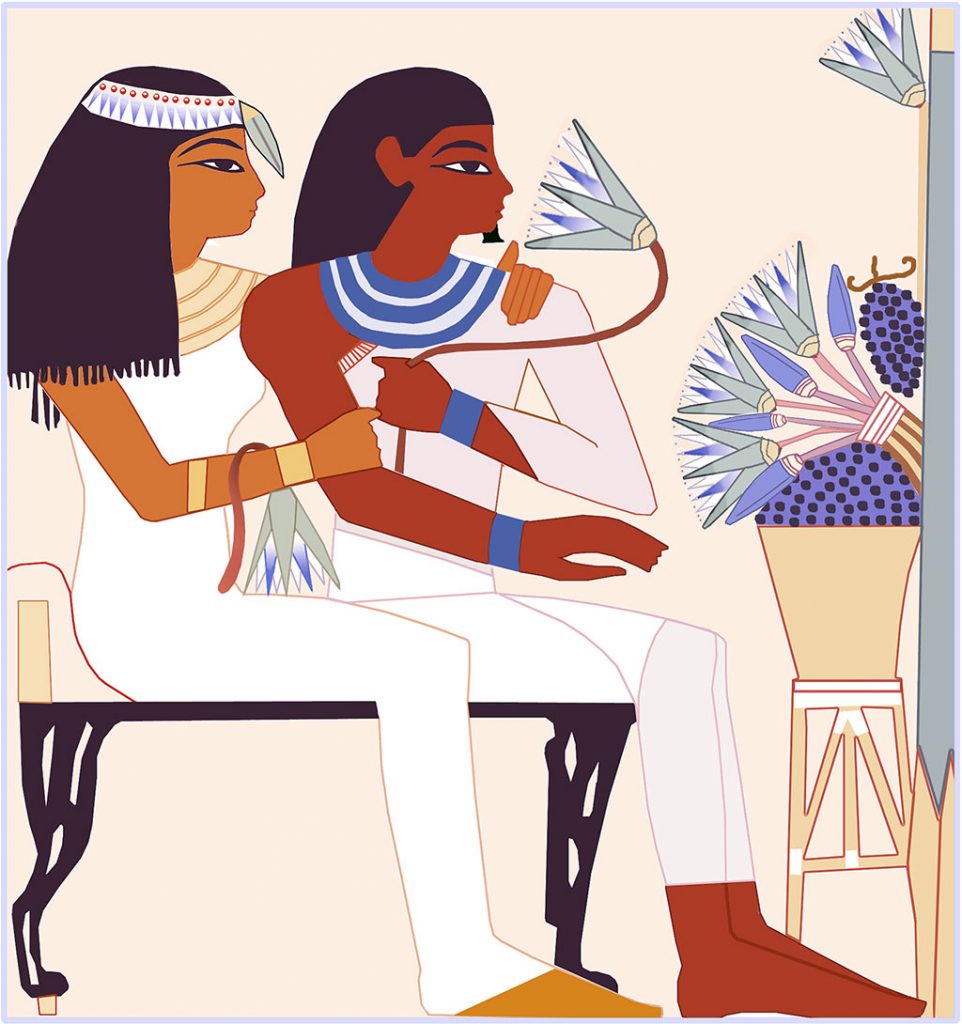
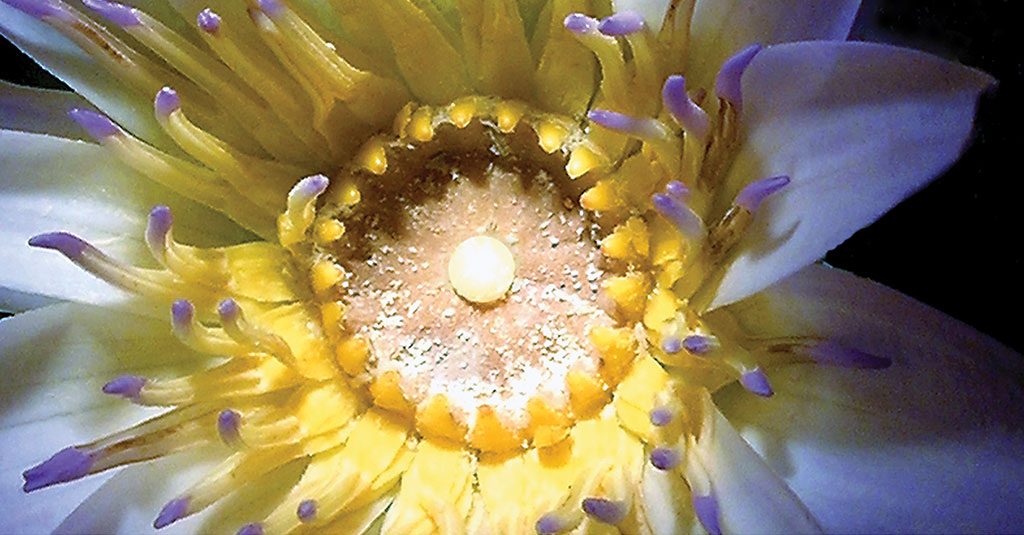

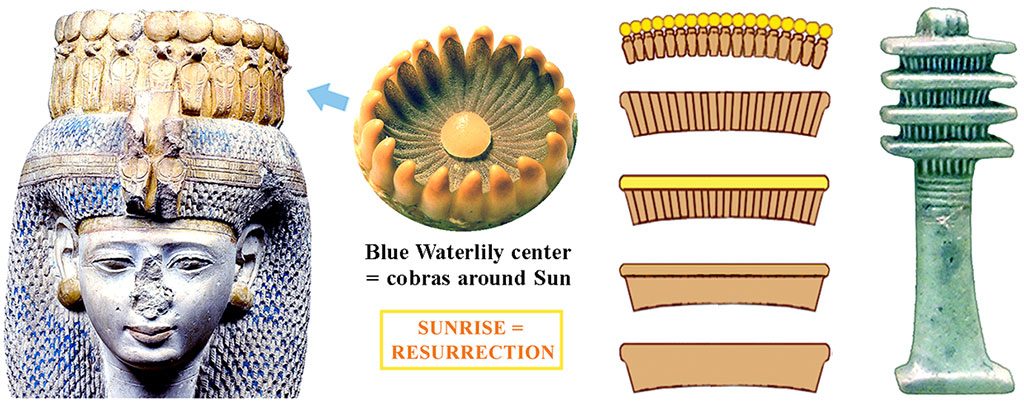

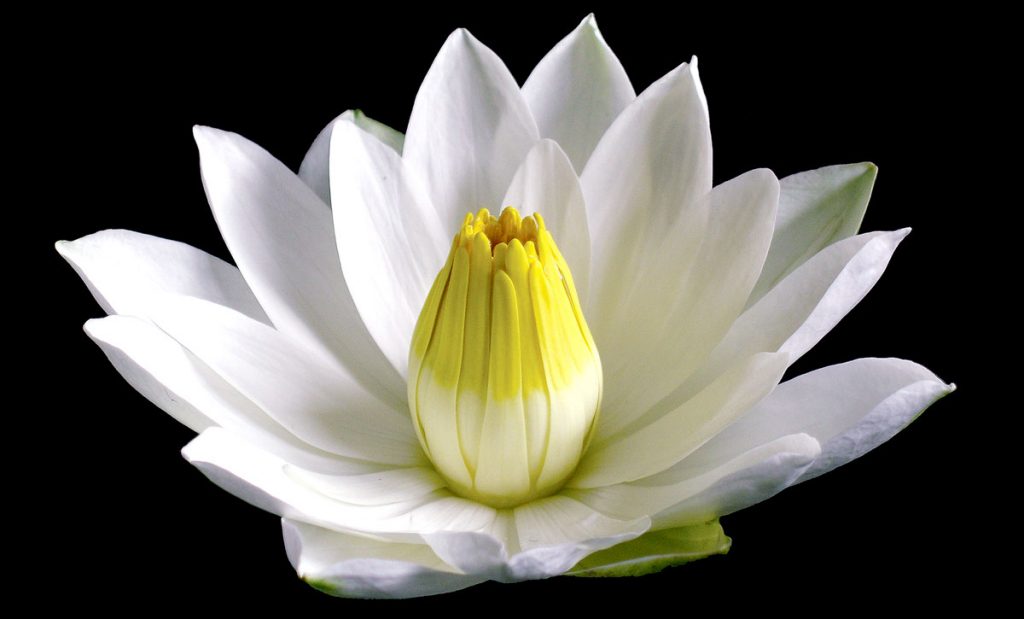
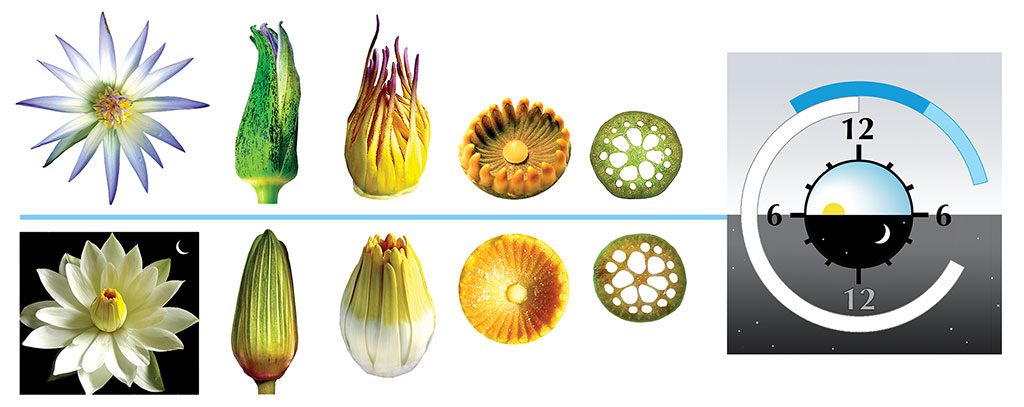

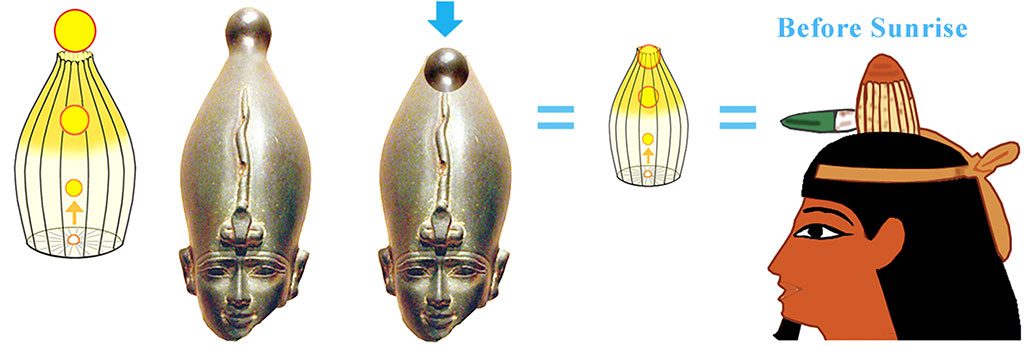

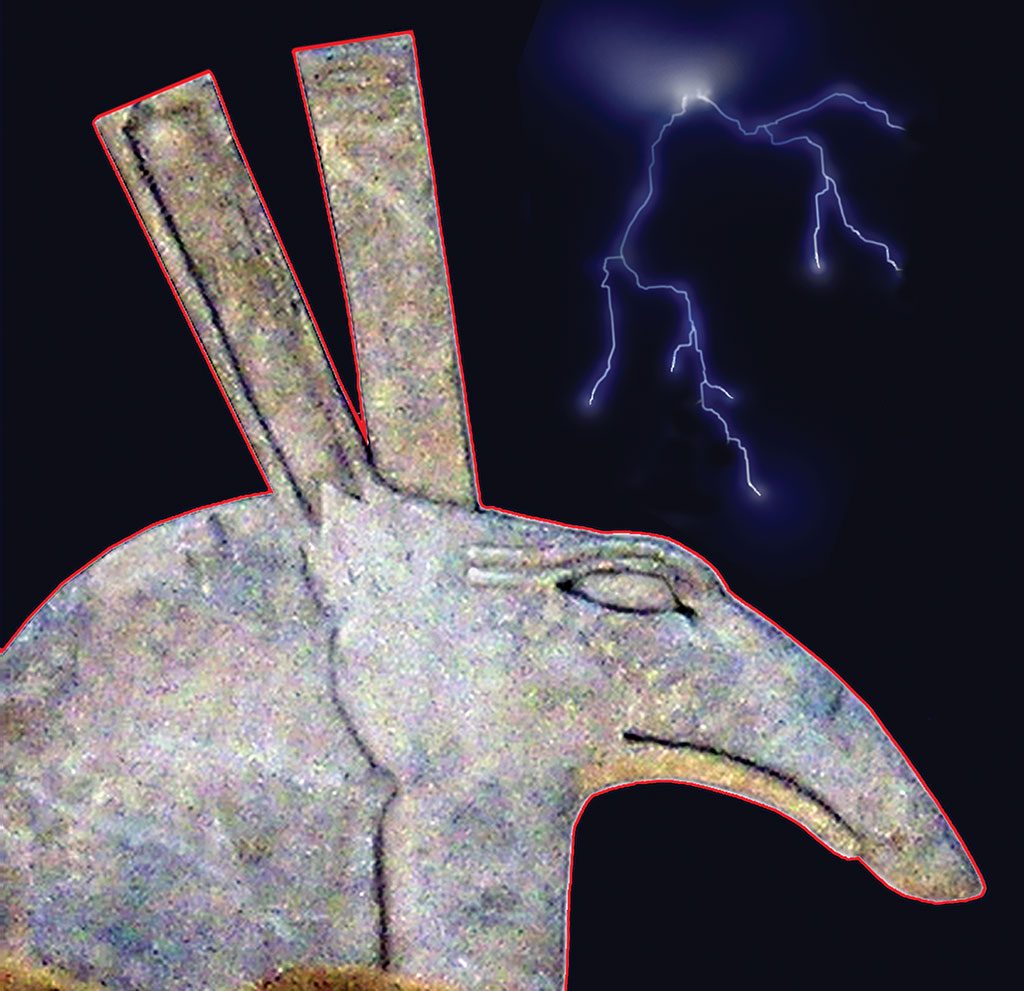

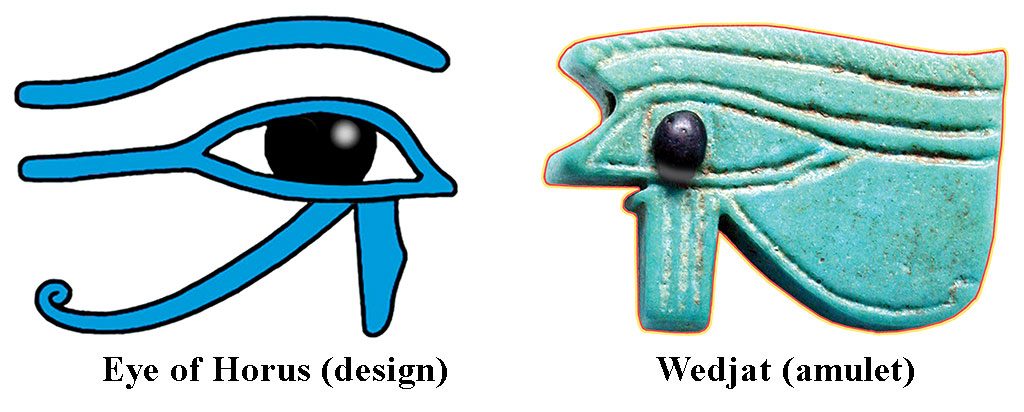
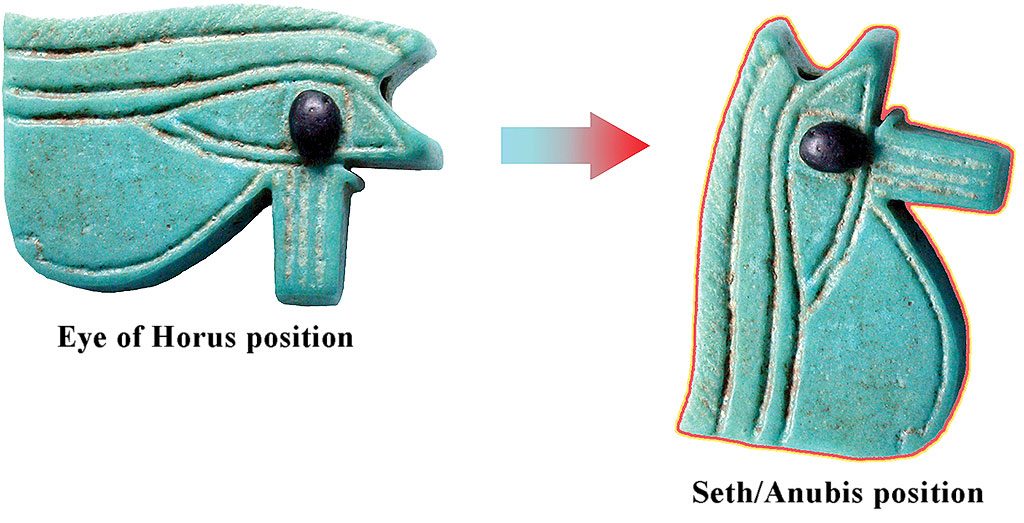
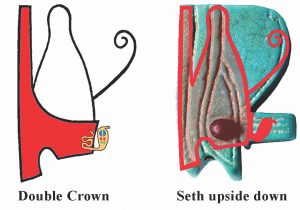
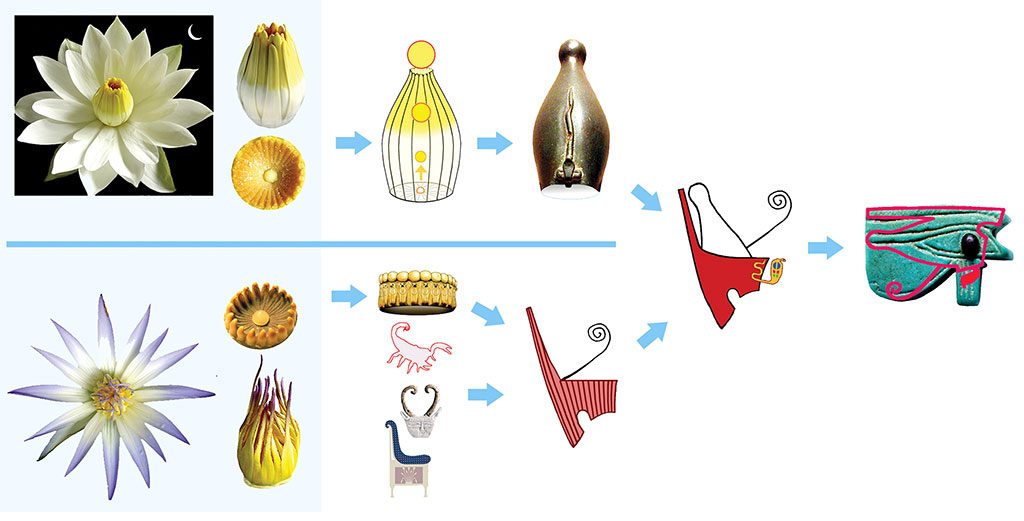

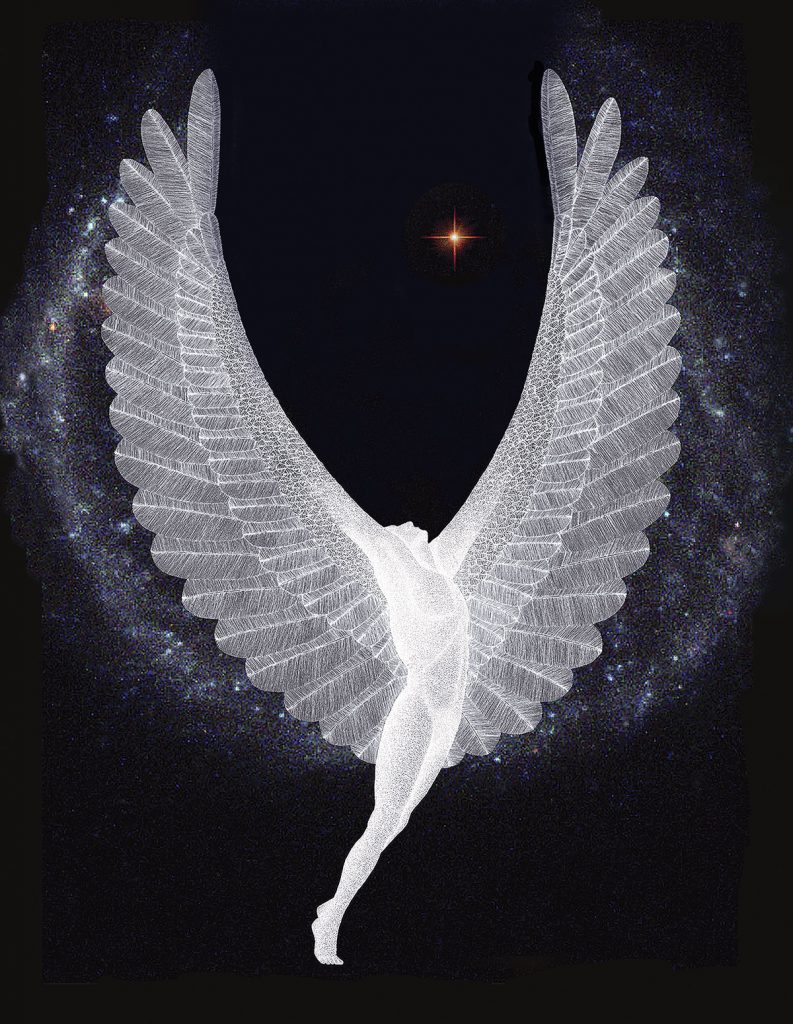
As many or perhaps all of the symbols which informed the ancient languages of Egypt and Sumer were grounded in cosmology, expressed in terms of the Great Matriarchal Weaver with her capacity to create and manipulate the fabric of the cosmos, my reaction to this very interesting article is to type “lotus” and “weave” as a search. Images of the Matriarch where she is seen weaving on her cosmic circle loom are generally misinterpreted and take her to be a goddess of writing. (see the misnamed Seshat who wears the Sumerian symbol for sky above her head) Weaving took place in the sky but was also of major importance on land, and even the most spiritual of symbols originally possessed a practical aspect. As above, so below.
I understand that the major difference between lotus plants and water lillies is the length of their stalks above water, so forgive me if I am wrong but perhaps this holds true for both: “The tradition of making cloth with lotus fibres, however, has a much longer history. Once widespread throughout Buddhist countries in south-east Asia…(…) Drawn from the cut stems of the lotus plant, lotus fibres are fine, flexible and incredibly soft.”
http://wander-lush.org/lotus-weavers-weaving-textiles-inle-lake-myanmar-burma/
If true, it adds an extra layer to the importance of those beautiful plants in Egyptian imagery.
Thank you for your comments M Daines. You give me a lot to respond to. I looked at the link you sent and I Googled the Sumerian symbol for sky, but I did not see a resemblance to Seshat’s crown. Seshat’s Crown is a leaf (marijuana/hemp, 5-9 leaflets) under the outline of a side-view of a woman’s breast, which has commonly been misidentified as a bow and a crescent moon, neither of which have the nipple-bump at the apex. Seshat is not mentioned in this article, so let me explain that the ‘breast symbol’ over the leaf, when rotated to a front-view becomes the Sun glyph (a circle with a dot, or much smaller circle, in the middle). The Sumerian sky symbols I found were often star shapes, but without the stem that Seshat’s leaf has. I stuck closely to what I found in the Waterlilies, the ancient Egyptian symbols, the funerary texts, and what are the generally accepted definitions of the various gods and goddesses I mention – but many myths and variations evolved out of these inspirations. The Sacred Waterlilies: the major difference between the two Sacred Egyptian Waterlilies and the Sacred Indian Lotus, which came to Egypt ~600 BC, is their ovaries –both are in view when the flowers bloom. The Lotus has a woody ovary (cone-shaped), ~3.5″ across the top, with ~15-30 exposed pocket-seeds in hard shells. The difference is illustrated in our book. The dried Lotus ovary and stem is commonly used with flower arrangements. The Sacred Waterlily’s more-circular ovary is ~3/4″ across with ~2000 seeds hidden from view. Both their stems have been put to multiple uses. There are also many similarities between the two. I appreciate your last comment. I feel that Barbara and I may have opened a door, but others will fill in the many mythological details. Your first sentence is very interesting, but I will have to learn more about this. Thank you for taking the time to write.
Hello again, the link was simply to indicate the site where I found the mention of lotus as a fibre. As for Seshat, I know that you didn’t mention her. I was simply showing that she is, in fact, a weaver using a circle loom and, by that, making the connection to the lotus fibres. Pictures of her show a line going upwards into a star. I’m not a specialist of Egyptian imagery so perhaps there are more telling images than the ones I have seen. This said, there is only one Sumerian sign for the sky (AN) an eight-pointed star which, extending from her head, would indicate that she is the cosmic weaver. The misunderstanding between us is that I was writing about a cuneiform symbol with linguistic meaning, not just an image. Also, I have seen another image where an Egyptian goddess is clearly wearing the Sumerian symbol SHESH on her head. It could be that she is weaving hemp! But I don’t think she’s wearing it or even that it’s a crown. As I see it, there are her two snakes on either side of the symbol. These are Hindu SHESHA, and Sumerian SIS/SHESH, the siblings, (hence her mistaken identity as SESHAT), the cosmic snakes. The nipple-bumps are their heads.
By the way, this was not meant to be a critique of your article. But I see that we profoundly disagree on that particular symbol, so we will have to agree to disagree because there are none of the ancients left to put us straight! Your images are beautiful, and the subject of the water-lilies thought-provoking. Imagine having clothes made of waterlily stems…
Kind regards,
Madeleine Daines
Madeleine, That’s fascinating, because there is an example of Seshat wearing a crown that includes two snakes meeting head to head over a star…however, it rises our of an ancient Egyptian Cobra-Ring on her head. Of all the Seshat Crowns we found – I have 6 examples in our book – only one included snakes. It was not difficult to find the source of the breast symbol in her crown because it is identical to the ancient Egyptian glyph for breast (see James P Allen’s book Middle Egyptian, page 427, #27). Or, Google Seshat’s Crown – but be sure to look at ancient examples; there are modern interpretations mixed in. I tried to follow where the images led. Thank you for alerting me to the possible Sumerian influence. A thought: sometimes ‘similarities’ of form are a reflection of the “archetypes’ that “exist in the souls of all people” (Manfred Lurker, Egyptologist).
My thought is still that the images where the snakes are not identifiable were stylized, modern versions as an artist might well do today. But then I’m not familiar with the Egyptian glyphs. I’ve acquired a copy of the gigantic book handwritten by Champollion but haven’t opened it yet.
The Sumerian sign for breast, young, child, and the verb to nurture is very simple: a pair of triangles pointed downwards with short lines from the points, no doubt to show the milk. Phonetic value is TUR. I’ve seen a picture of the Egyptian tree of life with this integrated. My conviction is that Sumerian, Egyptian and other languages stem from the same, extremely ancient source, but that may not be the source of every image out there. Symbols may not always be language – lest I forget. As for so-called Sheshat, never underestimate the Great Weaver…she still decides our fates even if we have forgotten her! And let’s not go calling her an archetype. I don’t think she’d be very pleased…
Great work. What can you do with the symbolism surrounding Seshat?
Sestet’s Crown is one I write about in our book. I believe, as do many I came across on the internet, that the leaf, with 5, 7 or 9 leaflets, is a marijuana leaf. Many have suggested that the arching line over the leaf is a crescent moon, or a bow; however, neither have that hump in the middle. That arching line is identical to the ancient Egyptian glyph for a woman’s breast (side view)…and when you turn that to a front view it becomes the glyph for the sun – a circle with a much smaller circle at its center. It is a [maternal] sun symbol over a sun-loving plant. I also mention evidence of marijuana use in ancient Egypt. Here is an interesting quote from Lisa Maniche, Egyptologist: “The ancient Egyptian word “smsmt” was in the past wrongly taken to mean “sesame” but has now been shown to be Cannabis Sativa.”
I misspelled Manniche. Her quote is an example of why more is not known about marijuana/hemp use in ancient Egypt. Another reason is the modern prejudice against it.
You should read the website > http://www.GodElectric.org . They have totally rediscovered Egyptology showing how special characteristics of the animals and plants describe the physics of an electric cosmos. The hieroglyphs are a gift from the cosmos where the supply or nourishment of negative charge to celestial bodies is described in order to support life.
I took a look Arthur, very interesting, and I’ll look more later. It’s fascinating how many different ways there are to look at life. It brings to mind Jorge Luis Borges’ (blind Argentine writer) short story The Aleph. “In Borges’ story, the Aleph is a point in space that contains all other points. Anyone who gazes into it can see everything in the universe from every angle simultaneously, without distortion, overlapping or confusion.” Wikipedia. And here’s a quote from Manfred Lurker, a favorite Egyptologist of mine, about archetypes, another interesting source of symbolism: “Symbols are not confined to time and place, but to a large extent follow certain rules independent of ethnic tradition and religion. Psychologists have established that images do not only approach… people from the visible world but also exist in the depths of… each soul, the unconscious. Archetypes enter the conscious mind in the form of symbols and myths…archetypes exist in the souls of all people.”
Seth’s head shape looks to me like a hand in profile, possibly symbolizing a snake?
Good observation Django. That’s how I approached the material too, by considering what symbols resemble. However, in this case, since we know from ancient Egyptian myth that Osiris represented fertile land, the plow is more relevant (although, interestingly, the snake is also a symbol of Seth/plow, god of death). I discuss this in our book, and mention a ceremony (Osirian Festival of Khoiak) that comes when the inundation (annual 4 month flooding) recedes. The festival is a plowing and planting ceremony that “Symbolically corresponds to the death, dismemberment and interment of Osiris in the earth” (Jeremy Nadler, Egyptologist). Keep in mind that this article is only a much abbreviated reflection of our book, which lays all this out in greater detail. I abridged the book so I could get the price down to $20 with free delivery.
Nice work… Also note the most obvious pre-occupation with the Blue ‘Lotus’ Waterlilly is its blissful odour when distilled as an ‘absolute’ essential oil and its extra-intoxicating taste when fermented in wine … All the depictions of the waterlilly clearly show it being sniffed and drunk from wine vats that contain the petals floating in the wine.
By the way – although very expensive, because of its rarity nowadays – the oil simply must be inhaled to be believed, if you can get it. I found it in New York’s http://www.enfleurage.com
You are absolutely right Bruno, the Sacred Ancient Egyptian Blue Waterlily has a subtle but lovely odour. One can find examples on the internet of experiments people have done using parts of the Waterlilies steeped in wine to make a mind-altering drug. I tried this too, but found the results to be soporific – unpleasant tasting and leaving me drowsy and drunk feeling (1 teaspoonful). However, it is natural to want to alter one’s consciousness (Andrew Weil, MD, The Natural Mind), and people will use whatever means is available, even if it is nasty tasting. Andy and I stayed for several weeks one winter in 1970 with a Sioux medicine man in South Dakota to learn Sioux medicine.
About the electric Universe
Watch On you tube “thunderbolts of the Gods” theful movie
I’ll take look. Thanks for letting me know about it.
Fascinating study. I look forward to studying it in more detail. At first look of these pictures, however, something jumped out at me: the image of the waterlily seed. Many questions have been raised about the meaning of the item that the various “magicians, sages, wise men, etc.” are carrying in their right hands (and their “doctors’ bags in their left) and offering to others. I think it is the embodiment of the waterlily seed. There are also stone “things” whose meaning remains elusive; one of them I have seen also looks like this waterlily seed. Finally the images in Rosslyn Chapel that people think are corn might, in reality, have been the images of waterlilies, which look like corn before it has been husked, as can be seen in one of the pictures above. Perhaps this idea is discussed in the book.
That’s great Kathi. You bring a unique set of eyes, and have seen a variety of possible connections. Ancient Egypt belongs to us all; it’s not the private domain of scholars, who in some cases have made people feel uncomfortable offering suggestions. Not to dis Egyptologists, who are truly some of the hardest working people I have ever met, but, as our book demonstrates, much has been overlooked that some of us without a scholarly background can help with. In my case, as an artist I notice details in images…and when I see them repeated I look closer and question why. The Waterlily seeds are quite tiny, about the size of poppy seeds, so ancient Egyptians may not have seen many details. Good luck running down clues.
just scrolling through, it seems like random lines and shapes from different objects were assumed to be connected.. I’m no Egyptology or symbol expert here but the whole eye of Horus turned over and the lines matching with the hats thing seems a little far-fetched.
Challenging and questioning can be the beginning of finding the truth, so I agree with your approach. There is a lot more detail about these discoveries in our book, of course, so if the subject interests you I hope you take a closer look. Much of the evidence for our discoveries about the Eye of Horus is from the ancient Egyptian funerary texts (ancient Egyptian’s words, 2250 – 30 BC), which you can read above…pretty powerful evidence, don’t you think? The “hats” are also called crowns, and since the sun was “known” to reside in the Waterlilies, and since sunrise was the time of resurrection, a crown based on the Waterlilies was a resurrection machine, helping that person achieve resurrection. It’s an exciting subject, well worth your time.
If my memory serves, the blue water Lilly nymphae capensis or nymphae cerulea was the national flower of Atlantis and hence its association with ancient Egypt. As you will no doubt see, the blue water lily is always cut, on altars or adorning sacred items but never growing. This is showing that the atlantean culture being worshipped is not in their homeland. He also inferred that the atlantean culture built the pyramids and the incredible mason features after the destruction of their home.
The blue water lily has other interesting qualities. Tropical water lilies, of which capensis and cerulea are, open and close 3 days in a row ( resurrection and also related to the Jesus mythology). It is only on the first day flower that the inner sanctum to solar palace is open and a large amount of liquid is revealed. This liquid was used in a sublime healing and transcendent spiritual ritual and is part of the alchemical process of awakening which is why it is featured so prominently adorning temples and art. There is too much information for this forum but suffice to say the colour and fragrance also play a great role. When the sarcophagus of Rameses ( can’t remember which one) was opened, he was wearing a garland of blue water lily petals and sepals which had remained blue and we’re still mildly fragrant! ( dried petals stay dark blue and hold they fragrance) . The Egyptian glyphs found in Australia along with the N. Cerulea all along the eastern seaboard continues this story…. Did the Egyptians visit the Australians? Or was it the atlantean a that also arrived on the eastern sea board of Australia bringing their sacred blue water lilies with them…. Happy to wax lyrical so email me for more. I have been growing sacred lotus and water lilies for 25 years and have presented on this topic before, thanks for the posting.
My reply is below in grey. I misfiled it.
Addition to comment above.. The reference to Atlantis is from Swaller de Lubitz
At times it seemed you were quoting from our book…some of our information is that closeto yours. You mention the stigmatic basin (little dish-like center of the flower with the sun in the middle) is full of liquid on the Waterlily’s first day open. Some bees fall in and drown…which leads to another important symbol in Egyptian mythology…that of the dead riding in a Solar Boat…which is also the Solar Eye, based on resemblance. Ken Landon, the man who grew our Waterlilies examined flower remains for ancient tombs at the request of the Egyptian government. Have you worked with him? I’m glad to learn of some of the other layers of meaning you have gleaned from the Waterlilies; the Atlantis – Australia link sounds fascinating. Henry Conard, author of the Waterlily bible (The Waterlilies) and Ken Landon, spell it “Waterlilies”; I capitalize ancient Egyptian religious symbols in our book. I’d be interested in learning more, but don’t have your email; mine is on my website.
We tried to find the symbolic foundation on which the ancient Egyptian mythology was based – what had inspired the symbols, because that, we conjectured, would have a lot to do with what they meant and how they evolved as symbols. These were the symbols in their “purest” form, before layers of other meanings were attached. A good example is the suspected homosexuality between Osiris and Seth, and Seth and Horus, in common myths. It arose from an effort to decipher the basic symbolism: an eye, because of its shape, was a female symbol (Stephen Quirke, Egyptologist), and yet Horus was definitely a man…so what was the symbol telling them? And the other symbolism is Seth plowing Osiris, which is a universal symbol of intercourse. These were the two basic reasons the question of their sexuality arose. In their purest forms these symbols were thought to be clues left by the Gods and Goddesses to help people make sense of the world, so they were highly motivated to understand them.